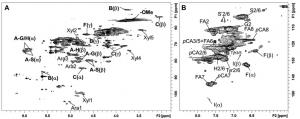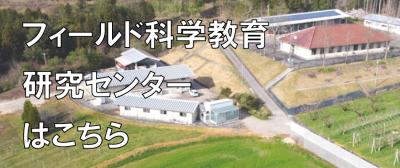本文
【地域資源開発学科】タケ培養細胞株のリグニン蓄積の特性をHSQC-NMR解析で明らかに!
印刷用ページを表示する
2022年3月18日更新
【地域資源開発学科】荻田教授の研究が学術論文として採択されました
本研究は,Holzforschung誌に掲載されます。
HSQC-NMR analysis of bamboo (Phyllostachys nigra)-cultured cell lignin produced under different phytohormone conditions
Qu, Chen, Ogita, Shinjiro, Kawamoto, Haruo and Kishimoto, Takao
TBamboo-cultured cells (BCCs) were produced under three phytohormone conditions. BCC lignin was then isolated and characterized by heteronuclear single-quantum coherence-nuclear magnetic resonance (HSQC-NMR) analysis. HSQC-NMR analysis revealed that all three BCC lignin samples were composed of guaiacyl (G), syringyl (S), oxidized syringyl (S′), and p-hydroxyphenyl (H) units. p-Coumaric acid (pCA) and ferulic acid (FA) were identified as well. Main lignin substructures, including β-O-4, β-5, and β-β, were also detected. However, β-O-4/α-O-4, spirodienone, dibenzodioxocin, or tricin structures were absent in the BCC lignin. The BCC lignin contained higher proportions of H, FA, and β-5 structures, but less proportions of S, S′, and β-O-4 structures than the mature bamboo lignin. The removal of auxin 2,4-dichlorophenoxyacetic acid (2,4-D) from the subculture medium promoted G unit formations.
Nevertheless, it suppressed H and pCA unit formations. Cytokinin 6-benzyladenine (BA) promoted H and β-β structure formations as well but suppressed β-O-4 formations than in the mature bamboo and BCC lignin produced under phytohormone free conditions.
Nevertheless, it suppressed H and pCA unit formations. Cytokinin 6-benzyladenine (BA) promoted H and β-β structure formations as well but suppressed β-O-4 formations than in the mature bamboo and BCC lignin produced under phytohormone free conditions.
独自に樹立したハチクのモデル培養細胞Pn(rpc00047:https://plant.rtc.riken.jp/resource/cell_line/web_documents/cell_lines/rpc00047.html
)を用いて、植物細胞壁成分であるリグニンなどの組成が植物ホルモンの添加によってどのように変化するかをHSQCスペクトル解析(高分解能2次元NMR測定法)により明らかにした。Pn細胞は培養条件によって特徴的な二次代謝能力を発現することが分かっており、荻田研究室では引き続き植物培養細胞を活用した研究を進めて行きます。本論文は、富山県立大学工学部生物工学科岸本准教授との共同研究成果です。
)を用いて、植物細胞壁成分であるリグニンなどの組成が植物ホルモンの添加によってどのように変化するかをHSQCスペクトル解析(高分解能2次元NMR測定法)により明らかにした。Pn細胞は培養条件によって特徴的な二次代謝能力を発現することが分かっており、荻田研究室では引き続き植物培養細胞を活用した研究を進めて行きます。本論文は、富山県立大学工学部生物工学科岸本准教授との共同研究成果です。

 大学概要
大学概要
 学部・大学院・専攻科
学部・大学院・専攻科
 学生生活・就職支援
学生生活・就職支援
 研究・地域連携・国際交流
研究・地域連携・国際交流
 入試情報
入試情報






